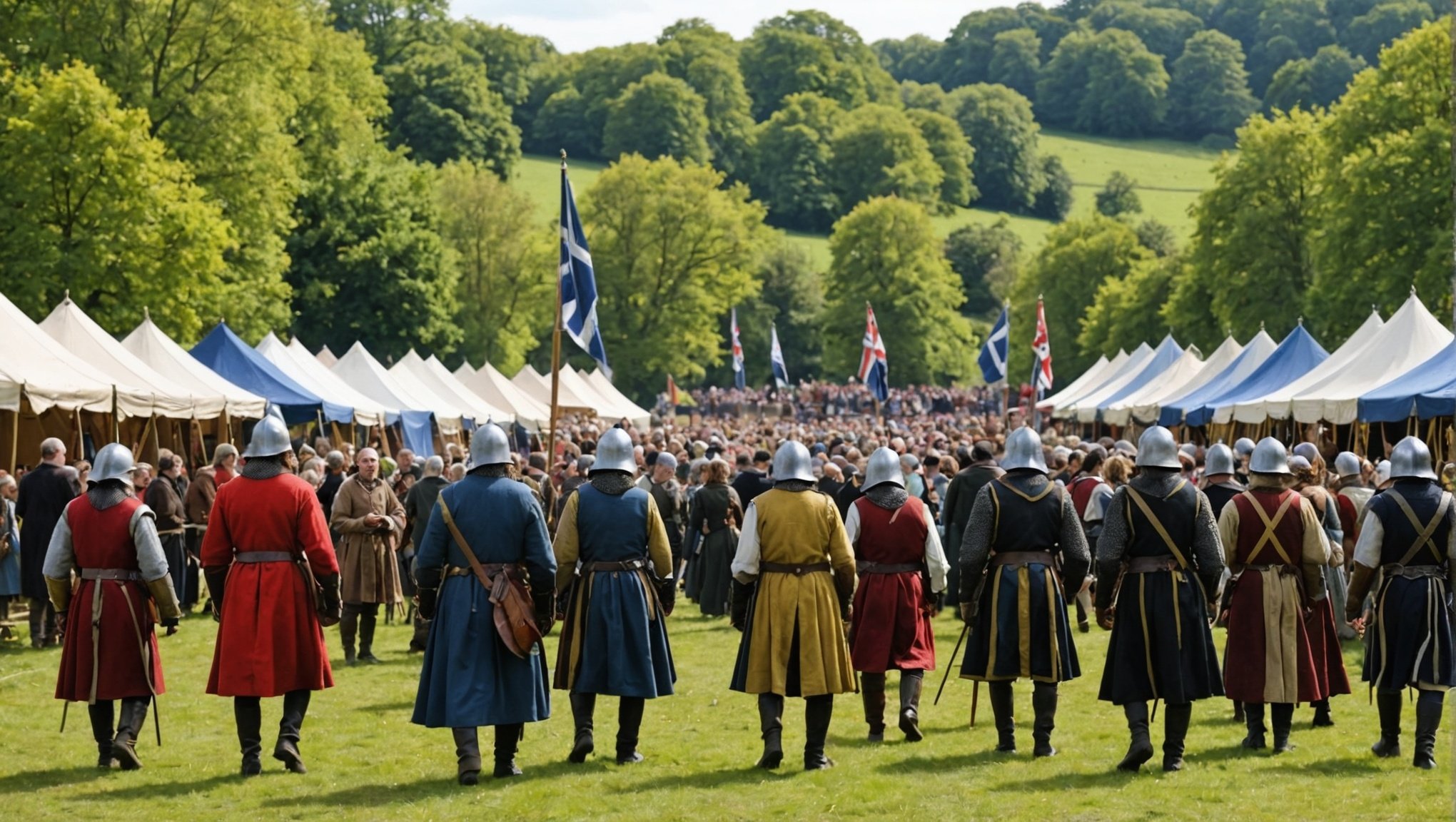Step back in time and immerse yourself in the rich heritage of medieval England. The UK's medieval fairs offer vibrant showcases of authentic British crafts, where artisans demonstrate age-old techniques. From intricate pottery to exquisite textiles, these events bring history to life. Discover the top fairs that celebrate tradition and craftsmanship, ensuring a memorable experience for anyone eager to connect with the past. Embrace the spirit of the era and support local artisans, all while enjoying a unique, festive atmosphere.
Overview of Medieval Fairs in the UK
Medieval fairs in the UK are a vibrant celebration of history and culture, offering a glimpse into the past with their historical significance. These fairs were originally established as important trading hubs during the Middle Ages, where merchants gathered to exchange goods and services. Today, they serve as a cultural event, drawing locals and tourists alike to experience the rich tapestry of medieval life.
This might interest you : Explore the Top UK Locations for Unforgettable Guided Tours of Ancient Roman Architecture
The types of crafts showcased at these fairs are diverse and captivating. Visitors can explore stalls featuring traditional crafts such as blacksmithing, weaving, and pottery. These crafts are not just for display; artisans often demonstrate their skills, providing an immersive experience for attendees. This hands-on approach helps preserve ancient techniques and educates the public about the craftsmanship of the medieval era.
The cultural impact of medieval fairs on local communities is profound. They foster a sense of identity and pride among residents, while also boosting the local economy by attracting visitors. These events provide a platform for cultural exchange, where people can learn about and appreciate the traditions of the past. Medieval fairs are more than just entertainment; they are a testament to the enduring legacy of the UK's rich cultural heritage.
In the same genre : Discover the Top Ways for Tourists to Master Traditional Welsh Harp Music in Cardiff
Top Medieval Fairs to Attend
Exploring the best medieval fairs in the UK is a journey through time, offering unique experiences that captivate both history enthusiasts and casual visitors. Here’s a detailed look at five must-visit fairs, each with its own charm and historical allure.
1. Tewkesbury Medieval Festival
- Location: Gloucestershire
- Dates: July
- Unique Features: Known for its large-scale reenactment of the Battle of Tewkesbury, this festival offers visitors a chance to witness history come alive with authentic costumes and dramatic performances.
2. Ludlow Medieval Christmas Fayre
- Location: Shropshire
- Dates: November
- Unique Features: Set in the picturesque Ludlow Castle, this fayre features traditional crafts, festive entertainment, and a medieval market, making it a perfect winter event.
3. Jousting Tournament at Hever Castle
- Location: Kent
- Dates: Various weekends from July to August
- Unique Features: Experience the thrill of medieval jousting alongside falconry displays and archery demonstrations in the historic grounds of Hever Castle.
4. Loxwood Joust
- Location: West Sussex
- Dates: August
- Unique Features: This fair combines historical reenactments with live music, storytelling, and a bustling marketplace, offering a family-friendly atmosphere.
5. St Ives Medieval Faire
- Location: Cambridgeshire
- Dates: September
- Unique Features: With its focus on medieval history and culture, this fair includes a variety of activities such as workshops, live demonstrations, and medieval games.
Featured Crafts at Medieval Fairs
Exploring authentic British crafts at medieval fairs offers a unique glimpse into the artisanal skills of the past. These fairs showcase a variety of artisanal products, each representing a piece of historical craftsmanship. From the clang of the blacksmith's hammer to the intricate patterns of a weaver's loom, visitors are immersed in a world where traditional techniques are brought to life.
Artisans at these fairs are not only skilled in their craft but are also passionate about preserving these ancient arts for future generations. Notable artisans, such as master potters or seasoned blacksmiths, often take center stage, demonstrating their expertise and sharing the stories behind their work. These craftsmen and women are dedicated to maintaining the authenticity of their craft, ensuring that the skills are passed down and not lost to time.
Preserving these crafts is crucial, as they form an integral part of the UK's cultural heritage. By maintaining and showcasing these skills, medieval fairs play a vital role in educating the public and keeping history alive. The continuation of these traditions allows for a deeper appreciation and understanding of the artistry and dedication involved in creating artisanal products.
Activities and Entertainment at the Fairs
Medieval fairs in the UK are a treasure trove of entertainment, offering a wide array of activities for families. Visitors can enjoy a variety of performances, from jousting tournaments to lively medieval music and dance shows. These performances not only entertain but also provide a historical context, bringing the medieval period to life.
For those seeking a more interactive experience, fairs often host workshops where attendees can try their hand at traditional crafts. These workshops are a hit with families, as they offer a hands-on approach to learning about medieval life. Whether it's trying out calligraphy or learning the basics of blacksmithing, there's something for everyone.
Family-friendly attractions are abundant at these fairs. Children can participate in medieval games or enjoy storytelling sessions that capture the imagination. Many fairs also feature animal displays, such as falconry shows, which are both educational and entertaining.
In summary, medieval fairs provide a rich tapestry of activities and entertainment that cater to all ages. With a blend of performances, interactive workshops, and family-friendly attractions, these events offer an engaging and educational experience for all who attend.
Tips for Visiting Medieval Fairs
Visiting a medieval fair can be an enchanting experience, especially with the right preparation. Here are some visitor tips to ensure a memorable adventure.
Planning is crucial. Check the fair's schedule in advance to identify must-see events and performances. Arriving early allows you to explore at a leisurely pace and avoid crowds. Purchasing tickets online can save time and sometimes money.
When considering what to bring, comfort is key. Wear comfortable shoes as you'll likely be walking a lot on uneven terrain. Dressing in layers is advisable, as weather can be unpredictable. A small backpack can be handy for carrying essentials like water, snacks, and sunscreen.
Navigating the fair is an art in itself. Grab a map upon arrival to familiarize yourself with the layout. Prioritize activities and shows that interest you the most. Many fairs offer interactive experiences, so don't hesitate to participate and immerse yourself in the medieval world.
By following these medieval fair advice, you can maximize your experience and fully enjoy the vibrant atmosphere these events offer. Whether you're a first-time visitor or a seasoned attendee, these tips will enhance your medieval adventure.
Engaging with Artisans and Crafts
Visiting medieval fairs offers a unique opportunity for artisan engagement, allowing attendees to connect with skilled craftsmen and women who are passionate about their work. These fairs provide a platform for visitors to meet artisans, learn about their crafts, and gain insights into the historical techniques they employ.
One of the most enriching aspects of these events is the availability of hands-on experiences. Many fairs host workshops where attendees can try their hand at traditional crafts, such as pottery, weaving, or blacksmithing. These interactive sessions are not only educational but also offer a deeper appreciation of the artisans' skills and dedication. Demonstrations by master craftsmen provide a captivating glimpse into the meticulous processes involved in creating artisanal products.
Supporting local artisans extends beyond the fair itself. Visitors can purchase handcrafted items directly from the creators, ensuring that their skills and traditions continue to thrive. Engaging with artisans during the fair is a rewarding experience, fostering a greater understanding of the cultural heritage they represent. By participating in workshops and purchasing their goods, attendees contribute to the preservation and promotion of these invaluable crafts.
Historical Context of Medieval Fairs
Medieval fairs in the UK trace their origins back to the Middle Ages, emerging as pivotal events within the society and economy. Initially established as trading hubs, these fairs facilitated the exchange of goods and services, becoming essential to the economic landscape. Merchants from various regions gathered, transforming fairs into bustling centers of commerce. This economic significance was matched by their social role, as fairs became venues for cultural exchange and community gatherings.
The evolution of medieval fairs reflects their adaptability and enduring appeal. Over time, they expanded beyond mere trade to include entertainment and social interaction, becoming vibrant celebrations of cultural heritage. This evolution has allowed medieval fairs to persist into the modern era, where they continue to captivate audiences with their historical allure.
Modern fairs play a crucial role in preserving historical practices. They offer a platform for artisans to demonstrate traditional crafts, ensuring these ancient techniques are not lost to time. By showcasing these skills, medieval fairs contribute to the preservation of the UK's rich cultural tapestry, allowing visitors to experience and appreciate the historical context and significance of these time-honored events.
Local Insights and Recommendations
When planning a visit to a medieval fair, local insights can significantly enhance your experience. Understanding the surrounding area can make your trip more enjoyable and memorable.
For accommodations, consider staying in charming bed-and-breakfasts that capture the essence of the region. These places often provide a more personalized experience compared to larger hotels. If you're looking for dining options, local eateries offer a taste of regional cuisine. Many locals recommend trying traditional British dishes at nearby pubs, where you can enjoy hearty meals in a cozy atmosphere.
Exploring local attractions before or after the fair can enrich your visit. Historical sites, such as castles or ancient ruins, are often located nearby and provide a deeper connection to the medieval theme. Additionally, nature trails and parks offer a peaceful retreat from the bustling fair environment.
Insider tips suggest visiting fairs early in the morning or later in the afternoon to avoid the busiest times. This allows for a more relaxed experience and better opportunities to engage with artisans and explore stalls. Locals also advise checking the weather forecast, as some fairs are held outdoors and can be weather-dependent.
Visual Elements of Medieval Fairs
Medieval fair photography plays a crucial role in capturing the essence and vibrancy of these events. Through visual storytelling, photographers can convey the rich tapestry of history, culture, and community that defines medieval fairs. The dynamic scenes, from bustling marketplaces to vibrant reenactments, offer endless opportunities to create captivating images.
To take great photos at medieval fairs, consider these tips:
- Timing is key: Capture moments during golden hours—early morning or late afternoon—when the light is soft and flattering.
- Focus on details: Highlight the intricate craftsmanship of artisanal products or the elaborate costumes of participants.
- Engage with subjects: Interact with artisans and performers to capture authentic expressions and actions.
- Experiment with angles: Try different perspectives to add depth and interest to your photos.
Featured galleries from past fairs showcase the diverse visual elements of these events. They offer a window into the immersive experience, displaying everything from dramatic battle reenactments to serene craft demonstrations. These galleries serve as inspiration for both seasoned photographers and newcomers, illustrating the power of photography to preserve and celebrate the unique atmosphere of medieval fairs.
Conclusion and Further Resources
Exploring medieval fairs offers a fascinating journey into history, and there are numerous resources available for enthusiasts seeking deeper insights. For the latest medieval fair information, visiting official fair websites is invaluable. These sites provide updates on event schedules, ticketing, and special features, ensuring you don't miss any highlights.
For those interested in expanding their knowledge, several recommended books and articles delve into the historical and cultural aspects of medieval fairs. Titles such as "The Medieval Fair: A Historical Exploration" and "Fairs and Festivals of the Middle Ages" offer comprehensive overviews and detailed analyses. These resources provide context and enrich your understanding of the fairs' significance.
Online communities and forums are also excellent platforms for fair enthusiasts to connect and share experiences. Websites like Medieval Fair Enthusiasts Forum and related social media groups offer spaces for discussion, tips, and advice. Engaging with these communities can enhance your appreciation of medieval fairs, offering diverse perspectives and shared passion.
By utilizing these additional resources, you can deepen your engagement with medieval fairs, gaining both historical insight and practical information to enhance your experience.











